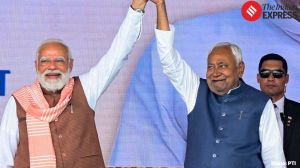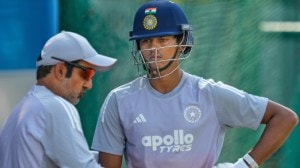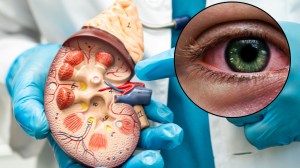A Letter From Panchur: ‘Countless letters for a bridge… schools have to shut in the rains’
Soon after it became clear on Thursday that the BJP was returning to power in Uttar Pradesh, and Yogi Adityanath would once again be its Chief Minister, villagers began converging at his paternal home in Panchur village of Pauri Garhwal, to congratulate his mother Savitri Devi and brothers Manvendra and Mahendra, who stay in the village with their families.
 The road leading up to Adityanath’s house (in blue) is the rare pucca one here. Entry is strictly regulated. (Avaneesh Mishra)
The road leading up to Adityanath’s house (in blue) is the rare pucca one here. Entry is strictly regulated. (Avaneesh Mishra)Soon after it became clear on Thursday that the BJP was returning to power in Uttar Pradesh, and Yogi Adityanath would once again be its Chief Minister, villagers began converging at his paternal home in Panchur village of Pauri Garhwal, to congratulate his mother Savitri Devi and brothers Manvendra and Mahendra, who stay in the village with their families. Adityanath’s father Anand Singh Bisht, a forest ranger, died in 2020.
By Saturday though, there were few signs in this village — located 10 km from the nearest town of Kaandi, surrounded by mountains with a thick green cover — of a celebration over its most famous native. The two police guards stationed outside were the only thing that put his two-storey house apart from the others around. The officers said only Savitri Devi was present in the house and there were strict orders not to let anyone in.
Falling under Seela gram sabha, Panchur remains as unsure about its celebrity status — proud of the achievements of Adityanath, or Ajay Bisht as they knew him, but disappointed about not benefiting enough from it.
 The bridge collapsed during the 2014 flash floods, awaits repairs. (Avaneesh Mishra)
The bridge collapsed during the 2014 flash floods, awaits repairs. (Avaneesh Mishra)
“Because of what Adityanath has achieved, our village is famous across the country. Since he first became UP CM, people and the media keep visiting his house. But the development it should have brought could not go beyond his house,” says 77-year-old Kanta Prasad Barola, sitting in a small open shelter room near Adityanath’s paternal house.
One of his hints is towards the pucca road leading up to Adityanath’s house, located at the entrance to the village. It was metalled after Adityanath became CM. Beyond the small stretch, across the gram sabha, there are only narrow kuchcha lanes.
Sitting by one such gali at his home, pradhan Urmila Badola says: “Road and transport are the biggest problems here. If you have to go beyond this point, walking is the only option, including to the government primary and higher secondary schools, which are around 2 km away.”
The nearest colleges are even further away, in Chamkotkhal, Bhirgukhal and Yamkeshwar. “To reach these, one must walk 8-10 km,” says Badola.
The challenges for the 54 students enrolled in the Seela Government Higher Secondary School and 13 in the Seela Government Primary School do not end here. While in winters and early summers, the students can still cross the Ravasan river on foot, in monsoon, it is impossible.
Around 50 metres from the schools is piled the debris of a bridge that collapsed during the 2014 flash floods. Girish Badola, the sarpanch’s husband and a teacher at the government high secondary school, says the bridge had been constructed in 1958. “Despite our numerous efforts and hundreds of letters to the government, there have been no repairs. As a result, the schools are shut from July to September every year.”
Girish claims that he also requested then BJP MLA from Yamkeshwar Ritu Khanduri to have the bridge built when she visited the village. “Promises were made, but nothing happened.”
Girish, 55, who says he was a senior to Adityanath, who is 49, at school, says the Gorakhnath Mutt head priest and CM would walk around 8 km to then Chamkotkhal Inter College for his higher classes. While the institution is now a degree college, little else has changed for the students, he adds.
According to Girish, Adityanath was a very bright student. “Everybody knew that. During his intermediate from Bharatmandir Inter College in Rishikesh, our chemistry teacher once asked him to join his coaching. Adityanath did not know how to ride a bicycle, and also did not need extra tuition, so he refused. When the results came, Adityanath was two marks short of passing with first division, mainly because he got less marks in the chemistry practical exam. I remember him crying uncontrollably and refusing to eat anything for the entire day,” he says.
Adityanath later went to Rishikesh and then Kotdwar to pursue a Bachelor of Science degree. Girish claims that his brush with student politics got him to the attention of the VHP and Mahant Avaidyanath. “Whenever we met, he would talk about the VHP and related ideologies. Back then I was a Communist and we used to have long debates. Now I myself am a BJP member,” Girish laughs.
Adityanath is believed to have participated in the movement for Ram mandir in Ayodhya and met Mahant Avaidyanath during an ABVP sabha in 1992. When he decided to make Avaidyanath his guru and left for Gorakhpur, he reportedly left even his family surprised. In Gorakhpur, he took sanyas and took on his new name.
Avaidyanath, a five-term MLA, was elected to the Lok Sabha from Gorakhpur as an Independent in 1970, again in 1989 as a Hindu Mahasabha candidate, and in 1991 and 1996 as a BJP nominee. He retired from electoral politics after that, handing over the seat and the Mutt to Adityanath, who was first elected to the Lok Sabha in 1998.
Pushkar Ratudi, 50, who says he studied with Adityanath in Classes 9 and 10, remembers him as very well-organised. “If he had stayed in the village, the maximum he would have been was a math teacher. He left, and became the CM.”
A village local says that Adityanath might have had some link to local politics of the Yamkeshwar Assembly seat earlier, but now he had none. “The locals have these memories of him and that is why we connect with him.”
According to him, it was Adityanath’s appeal that won Ritu Khanduri, the daughter of former CM and BJP stalwart B C Khanduri, the Yamkeshwar seat in 2017. This time, she was not given the ticket, reportedly because local leaders were unhappy with her. She contested from Kotdwar instead as a BJP candidate, and won.
From Yamkeshwar the BJP candidate this time was Renu Bisht, who won against Congress candidate Shailendra Singh Rawat by 10,410 votes.
Like in other interior villages of Uttarakhand, most youths and families of Seela have seen migration in search of jobs and better facilities. The combined population of Seela gram sabha’s seven villages is around 700. Locals say that from almost every family, someone works outside.
Most of them go to Rishikesh, Kotdwar or Dehradun for employment in the hotel industry, which in turn depends on tourism. Those who stay behind are involved in farming, a profession dwindling amid threat to crops by wild boars, monkeys and peacocks.
Adityanath’s younger brother Mahendra Bisht says he is aware of the issues faced by the locals and that he tries his best to help given his links. “Rebuilding the bridge that connects the gram sabha to the schools is a must. I have talked to our new MLA, Renu Bisht, and she has responded positively,” says Mahendra, who works as an administrative official at Mahayogi Guru Gorakhnath Degree College.
The Congress’s Rawat, who lost from Yamkeshwar, says that despite “not doing anything”, the BJP had won because people voted on national issues. “The area has issues like education, health and lack of tourism. Youth are leaving because there are no jobs.”
So when is Adityanath expected in Panchur next? No one is sure. His Lucknow office earlier said the CM wanted to come to seek the blessings of his mother, but now it is likely to only be after he has taken oath as the CM of UP.



- 01
- 02
- 03
- 04
- 05




























